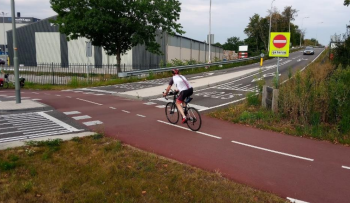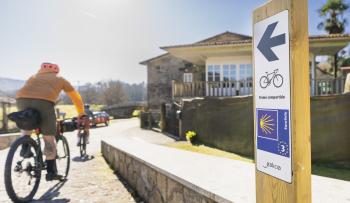
Revised TEN-T objectives and priorities for the first time include cycling and active mobility
Last week, the European Parliament voted to adopt the revision of the Trans-European Transport Network (TEN-T) guidelines. For the first time, the promotion of active modes of transport, particularly cycling, has been enshrined within the objectives and priorities of the TEN-T network.
TEN-T is the EU's primary network of roads, railways, inland waterways, ports, maritime shipping routes, airports and multimodal terminals. With the revision of the regulation, the EU aims to align TEN-T with the objective of cutting transport emissions by 90% compared to 1990 and increase connectivity across Europe. For many years, however, cycling, a key part of the equation for reducing transport emissions, had not been considered relevant for the network. This often resulted in the negative impact of TEN-T projects on active modes, with a new ring road or an upgraded rail line creating a barrier for walking and cycling.
“I am incredibly proud of our team's advocacy work in bringing about this significant milestone in the revision of the TEN-T regulation. For the past five years, ECF has worked on integrating cycling into the guidelines for developing TEN-T through collecting data, making the economic case, and providing recommendations on the practical integration of cycling.” said Jill Warren, CEO of ECF.
In a statement, Aleksander Buczyński, ECF Senior Policy Officer said “One of the lessons learned from the development of various cycle routes and networks is that they could have been a lot cheaper and easier to implement, if they had been integrated from the very beginning in other infrastructural projects. Retrofitting a cycle bridge into a motorway interchange or a cycle tunnel under a train station is much more complicated and expensive than including it in the design of the motorway or the railway.” Smart people do not pay twice.

The adoption of the revised regulation marks key changes for cycling, including:
- Definition of active modes
- Inclusion of health in the cost-benefit analysis
- Active modes as one of TEN-T objectives
- Taking into account synergies with cycling infrastructure, including long-distance cycle routes
- Active modes in TEN-T general priorities
- Active modes in additional priorities for railways, including cycle parking at stations
- Active modes in additional priorities for inland waterways
- Active modes in additional priorities for roads
- Obligatory Sustainable Urban Mobility Plans in urban nodes
- Multimodal passenger hubs accessible by active modes
- Mobility data indicators for urban nodes
What’s next?
By 2025, the European Commission aims to adopt an implementing act defining sustainability, safety, and accessibility indicators for urban nodes, and establishing a methodology for collecting and submitting data. By 2027,Sustainable Urban Mobility Plans(SUMPs) for more than 400 designated urban nodes are expected. ECF welcomes the collection of harmonised data on urban mobility in the TEN-T urban nodes and calls for the inclusion of cycling-specific indicators regarding modal split, safety, and infrastructure. Work on defining Sustainable Urban Mobility Indicators (SUMI) is already ongoing in the SUMP subgroup of the Commission Expert Group on Urban Mobility, in which ECF actively participates. Additionally, ECF advocates for SUMPs to include measures such as circulation plans and cycle highways.
By 2030, the revised regulation foresees the development of multimodal passenger hubs to facilitate first and last-mile connections, including access to public transport infrastructure and active mobility. In other words, major railway stations, bus stations, airports, and ferry terminals need to be connected to the cycle network of the urban node.
Read our full analysis of the revised TEN-T regulation here.
Our long-term vision for cycling in TEN-T includes:
- Integrating EuroVelo, the European cycle route network, within TEN-T. An ECF analysis in 2020 revealed that EuroVelo intersects with the TEN-T network nearly 8,000 times, underscoring the significant potential of integrating cycling into TEN-T.
- Systematically integrating elements of walking and cycling infrastructure into all TEN-T projects and network developments.
Topics:
Contact the author
Recent news!
Contact Us
Avenue des Arts, 7-8
Postal address: Rue de la Charité, 22
1210 Brussels, Belgium










